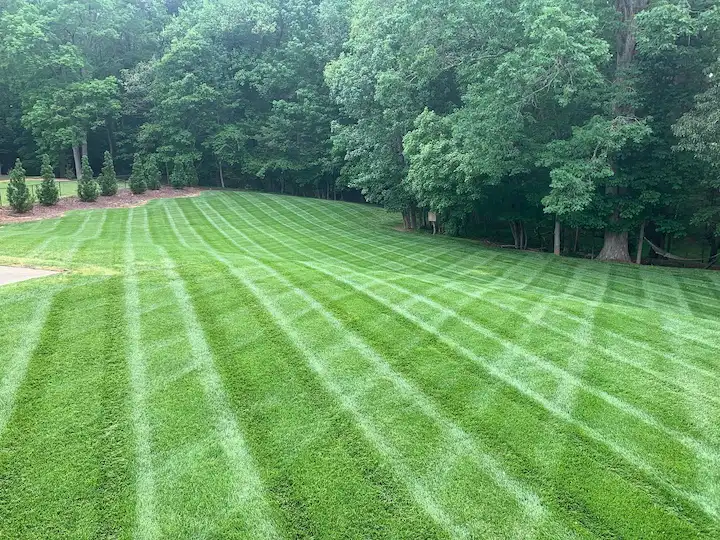
Maintaining a lush and healthy lawn requires more than just regular watering and mowing. One of the most common challenges faced by homeowners is dealing with weeds that can quickly overtake a lawn and ruin its appearance. While there are various methods to control weeds, pre-emergent herbicides are an effective and efficient solution that can prevent weeds from ever taking root. However, it’s essential to apply pre-emergent herbicides at the right time to ensure maximum efficacy.
Our weed control experts from FortSmith Landscaping in Wake Forest, NC are sharing the secret to a weed-free lawn by discussing what are pre-emergent herbicides and how to do it correctly. Whether you’re a seasoned gardener or a novice, this guide will provide valuable insights to help you achieve a beautiful, weed-free lawn.
What Are Pre-Emergent Herbicides?
Pre-emergent herbicides are a type of herbicide used to prevent weeds from sprouting and establishing themselves in a lawn or garden. Unlike post-emergent herbicides, which are applied to kill existing weeds, pre-emergent herbicides are applied before weed seeds germinate.
How Do Pre-Emergent Herbicides Work?
Pre-emergent herbicides work by creating a barrier in the soil that prevents weed seeds from germinating and growing. They do this by inhibiting the enzyme responsible for cell division in the seed embryo, effectively halting the seed’s growth before it can sprout.
Types of Pre-Emergent Herbicides
There are several types of pre-emergent weed control available, each with unique properties and modes of action. Let’s explore some of the most common types of pre-emergent herbicides to keep your lawn weed-free.
Granular Pre-Emergent Herbicide
Granular pre-emergent herbicide is a type of herbicide that comes in the form of granules. This type of herbicide is used for weed prevention by creating a barrier in the soil that prevents weed seeds from germinating and growing.
Granular pre-emergent herbicides are typically applied to the soil surface and then watered in to activate the herbicide. The granules dissolve in water and release the active ingredients, which then form a layer in the soil that prevents weed seeds from sprouting. This layer of protection can last for several months, depending on the specific product and environmental conditions.
Atrazine
Atrazine is a widely used pre-emergent herbicide that works by inhibiting photosynthesis in plants. It’s effective against a broad range of weed species and can be used on a variety of crops and turfgrass.
Dithiopyr
Dithiopyr is a pre-emergent herbicide that prevents cell division in the weed seed embryo, effectively stopping weed growth before it can begin. It’s commonly used on turfgrass, ornamental plants, and crops.
Isoxaben
Isoxaben is a selective pre-emergent herbicide that inhibits cell wall synthesis in weed seedlings, preventing the growth and establishment of weeds. It’s commonly used on ornamental plants, shrubs, and trees.
Prodiamine
Prodiamine is a long-lasting pre-emergent herbicide that works by inhibiting cell division in the weed seed embryo. It’s commonly used on turfgrass, ornamental plants, and crops.
Pendimethalin
Pendimethalin is a pre-emergent herbicide that works by inhibiting cell division in the weed seed embryo. It’s commonly used on turfgrass, vegetables, and field crops.
Oryzalin
Oryzalin is a pre-emergent herbicide that inhibits cell division in the weed seed embryo, preventing the growth and establishment of weeds. It’s commonly used on turfgrass, ornamental plants, and vegetables.
Benefin
Benefin is a pre-emergent herbicide that works by inhibiting cell division in the weed seed embryo. It’s commonly used on turfgrass, ornamental plants, and vegetables.
How to Choose the Best Pre-Emergent Herbicide for Your NC Lawn
Choosing the best pre-emergent herbicide for your lawn can be challenging, as there are many products on the market with different active ingredients and formulations.
Here are some factors to consider when selecting a pre-emergent herbicide:
- Weed type: Different pre-emergent herbicides are effective against different weed species. Identify the types of weeds that are common in your area, and choose a herbicide that is specifically formulated to control those types of weeds.
- Application timing: Pre-emergent herbicides should be applied at the right time for maximum efficacy. Consider the timing of the herbicide application and choose a product that works best for the season and climate in your region.
- Lawn type: Some pre-emergent herbicides can harm certain types of grasses or plants. Consider the type of lawn or plants in the area where you plan to apply the herbicide and choose a product that is safe for those plants.
- Soil type: The type of soil in your lawn can also affect the effectiveness of pre-emergent herbicides. Some products work better in clay soils, while others are more effective in sandy soils.
- Safety: Pre-emergent herbicides can be harmful to humans and pets if not used properly. Choose a product that is safe for use around children and pets and follow the label instructions carefully.
- Cost: Pre-emergent herbicides vary in price, and the cost can be a factor in choosing the right product. Consider the cost per application and compare products to find the best value.
- Longevity: Some pre-emergent herbicides provide longer-lasting control than others. Consider the length of time you want to prevent weed growth and choose a product that provides the appropriate level of control.
When Should You Apply Pre-Emergent Herbicides?
Pre-emergent herbicides are a useful tool in preventing weed growth in lawns and gardens. However, to maximize their effectiveness, it’s crucial to apply them at the right time of the year. In general, pre-emergent herbicides should be applied in early spring or fall, depending on the region and climate.
Early Spring Application
When you apply a pre-emergent herbicide in early spring, it can help prevent annual grassy weeds like crabgrass, foxtail, and goosegrass from germinating. The ideal time to apply pre-emergent herbicides in spring is when soil temperatures reach 55-60 degrees Fahrenheit for five consecutive days.
Fall Application
Fall is another ideal time to apply pre-emergent herbicides, especially for cool-season grasses like fescue and bluegrass. Applying pre-emergent herbicides in the fall helps prevent winter annual weeds like chickweed and henbit from germinating. Fall application should be done before the first frost, as the herbicide needs time to settle in the soil and create a barrier before winter weeds start to grow.
What Happens if You Apply Pre-Emergent Early?
Applying pre-emergent herbicides too early can result in reduced efficacy, as the herbicide may break down before the weed seeds begin to germinate or may not reach the weeds in time. Additionally, if the herbicide is applied before the soil temperature reaches the optimal range, it may not be activated, rendering it ineffective.
How To Apply Pre-Emergent Herbicides
Proper application is crucial for the effective use of pre-emergent herbicides.
Here are some general guidelines for how to apply pre-emergent herbicides:
- Read the label: Always read and follow the label instructions carefully. This will provide you with important information about the herbicide, including application rates, timing, and safety precautions.
- Prepare the area: Before applying the herbicide, remove any debris or dead plant material from the area to ensure even coverage. Rake or aerate the soil if necessary to promote good contact between the herbicide and the soil.
- Apply the herbicide: Apply the herbicide evenly over the soil surface using a spreader or sprayer. It’s essential to ensure that the herbicide is distributed evenly to prevent gaps or overlaps that can lead to uneven weed control.
- Water the area: After applying the herbicide, water the area thoroughly to activate the herbicide and ensure that it penetrates the soil.
- Follow-up: Pre-emergent herbicides typically provide several months of weed control, but follow-up applications may be necessary, depending on the weed species and environmental conditions. Always read the label instructions for guidance on follow-up applications.
Can You Put Too Much Pre-Emergent Down?
It’s certainly possible to put too much pre-emergent herbicide down, which can lead to negative effects. Overapplication of pre-emergent herbicides can cause damage to desirable plants and grasses, leading to stunted growth, yellowing, or even death. Additionally, overapplication can result in herbicide runoff, which can contaminate nearby water sources and harm aquatic life.
Tips For Maintaining A Weed-Free Lawn
Maintaining a weed-free lawn requires ongoing effort and attention. By following these tips and consistently implementing good lawn care practices, you can help to maintain a healthy, weed-free lawn that you can enjoy year-round.
Here are some tips for keeping your lawn free of weeds:
- Mow your lawn regularly
- Water deeply and infrequently
- Fertilize appropriately
- Aerate regularly
- Use post-emergent herbicides
- Use mulch
- Practice good lawn care habits
Contact FortSmith Landscaping And Keep Your Lawn Weed Free All Year
Are you tired of looking at a lawn full of weeds? Do you want to enjoy a lush, green lawn all year round? Look no further than FortSmith Landscaping, your local Wake Forest weed control experts.
Our team of professionals has years of experience in creating beautiful and healthy lawns that are free of weeds. Contact FortSmith Landscaping today and take the first step toward a beautiful, weed-free lawn that you can be proud of. Our team is ready to answer any questions you may have and provide you with a free estimate of our lawn care services.
Don’t settle for a lawn full of weeds. Contact FortSmith Landscaping today by calling (919) 228-8495 or filling out the contact form below to get started.
